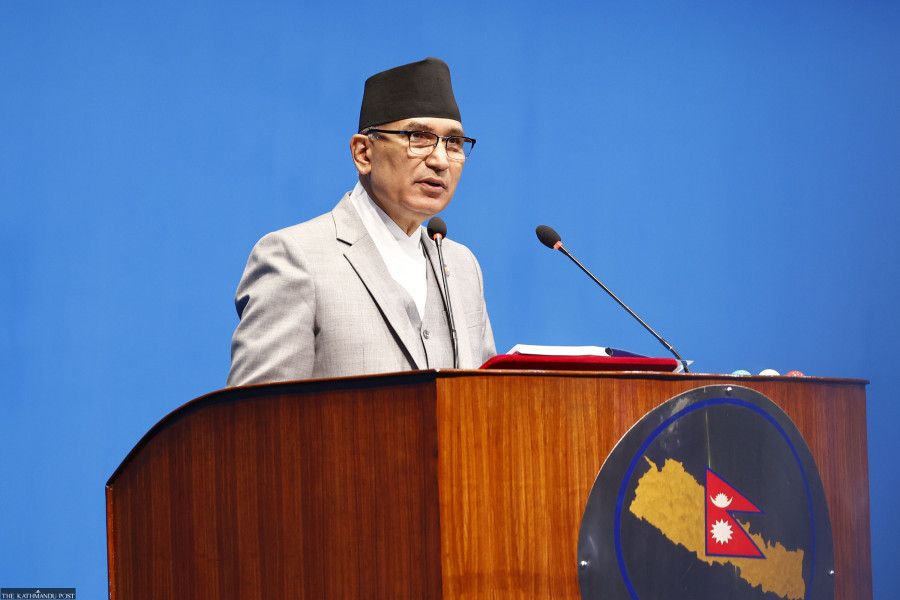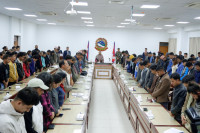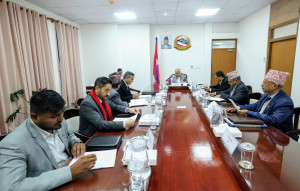Columns
A closer look at the budget
The federal government must not undertake projects that fall within the jurisdiction of provincial or local levels.
Khim Lal Devkota
A few weeks before the fiscal year 2025-26 budget was unveiled, I met Finance Minister Bishnu Paudel twice, requesting him to attend a pre-budget discussion programme from the perspective of federalism. The minister mentioned that he would not be able to participate in the programme but asked me to submit my suggestions in written format.
During a pre-budget discussion in the House of Representatives, Paudel remarked that the federal government’s plans and programmes, such as user committees and forest user groups, were smaller than those at the local levels. He sharply criticised federal ministries for continuing projects inherited from previous governments. He also announced that the federal government would no longer allocate budgets for projects costing less than Rs30 million. This declaration provided relief. (The “30 million policy” was approved during Prime Minister Pushpa Kamal Dahal’s tenure through a Cabinet-endorsed guideline. But the guideline had not been enforced.)
The Federalism Special Committee of the National Assembly, which I chaired during my tenure as a National Assembly member, had set a ceiling of Rs150 million in alignment with the spirit of the Constitution, which envisions that the federal government should implement infrastructure development projects of national pride, game-changing impact and strategic importance. This ceiling was determined through discussions with the National Planning Commission, the Ministry of Finance, the Office of the Prime Minister and other relevant bodies. The proposal for the ceiling came from the then Vice-Chairperson of the National Planning Commission, Biswo Nath Poudel, now the Governor of the Nepal Rastra Bank. However, the government implemented dozens of projects costing even less than Rs500,000, completely disregarding the ceiling. In this context, I accepted the NPR 30 million threshold in good faith and welcomed it, considering it better than nothing.
After the minister requested written suggestions, I, as Chairperson of the Federalism and Localisation Centre, submitted 52 recommendations to strengthen the implementation of federalism. One key recommendation emphasised that fiscal transfers should be based on the actual fiscal needs of provincial and local governments, following the principle that “funds follow functions” and aligned with appropriate institutional mechanisms. The federal government’s organisational structure should be significantly streamlined to reflect the true spirit of federalism. A national discourse on constitutional amendment should be initiated to make federalism more functional and outcome-oriented.
The centre also recommended expanding the limited financial authority of provinces. All types of grants flowing to provincial and local governments should be routed through the National Natural Resources and Fiscal Commission. The share of fiscal equalisation grants must increase relative to the national budget or GDP, and as these grants are a constitutional entitlement of subnational governments, they should never be reduced.
The federal government must stop initiating projects that fall within the jurisdiction of provincial or local levels. Except for nationally significant, strategic, or large-scale inter-provincial projects, small-scale projects should not be implemented by the federal government. The Rs30 million minimum threshold should be strictly enforced. Politically motivated project distribution must end, and project selection should be guided by objective criteria such as human development indices and infrastructure needs. Budget allocation must also reflect a fair provincial balance.
The practice of channelling funds to Constituency Infrastructure Development Projects through ministries such as Urban Development should be discontinued. The integration of police under provincial authority should be completed without further delay. Similarly, infrastructure development challenges, such as land acquisition, must be addressed. The Forest Act and Environmental Act should be amended to facilitate timely project implementation. Infrastructure, such as buildings handed over to provinces, should be legally registered in the name of the respective provincial governments.
Lastly, the practice of local officials frequently travelling to Singha Durbar to request key personnel, including Chief Administrative Officers, should end. Staff shortages at both local and provincial levels must be urgently addressed.
In the context of Nepal, federalism refers to the distribution of powers among different levels of government. Issues such as fiscal transfers to provincial and local levels, along with political, financial, administrative and intergovernmental relations, must be addressed through the budget. The budget is not merely a financial document outlining the government’s income and expenditure—it is an expression of political will, aimed at implementing the federal constitution. I hoped that most of the suggestions would be reflected in the budget speech, but that was not the case.
However, regarding project costing, finance minister announced in budget statement 362 that the government will not implement projects costing less than Rs30 million. “This is expected to support resource management for implementing national pride and nationally prioritised projects and to make project execution more effective,” he stated. He also mentioned that the number of projects has been reduced by 4,664 compared to last year. It was a commendable decision.
Nonetheless, my happiness was short-lived when I came across small-scale projects listed under the various ministries’ programme documents, including the Ministry of Urban Development. A June 8, 2025, article in this paper titled “Government goes against budget pledge not to implement small-scale projects” noted that several projects under one million rupees were still included.
This is a serious matter. Including small projects in the budget in a manner inconsistent with what the minister stated in the budget speech, in Parliament, and in public forums undermines the spirit of federalism and raises questions about the minister’s credibility. Even if the line ministries make mistakes, the ultimate responsibility for the budget rests with the finance minister. Nevertheless, I still have faith in the minister’s commitment and believe he will take the necessary steps to correct this.
When discussing the budget from the fiscal federalism perspective, there is much to be said and written. One notable issue is the declining trend in grants allocated to provincial and local governments. For example, excluding conditional grants, in fiscal year 2018-19, the share of the total budget allocated to local governments was 7.20 percent, and to provincial governments, it was 4.59 percent. In the current budget, these proportions have dropped to 5.54 percent for local governments and 3.42 percent for provincial governments.
A similar trend is observed in fiscal equalisation grants. In FY 2018-19, local and provincial governments received 6.44 percent and 3.83 percent of the total budget, respectively. In the current fiscal year, these figures have declined to 4.53 percent for local governments and 3.09 percent for provinces.
Finally, the federal budget reflects a troubling contradiction: While proclaiming a commitment to federalism, it continues to reduce fiscal grants and allow small-scale projects at the federal level. True progress requires aligning budgetary practices with fiscal federalism and honouring promises to empower subnational levels.




 18.12°C Kathmandu
18.12°C Kathmandu















